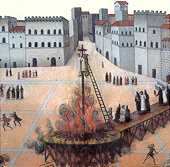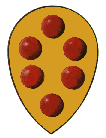|
|
|
|
|
|
|
Florence Italy travel guide |
|
|
Florence history from foundation to nowadays |
|
|
In this section you can find
a short but clear description is given for each
of the main historical periods. Just choose one of the following sub-sections
and you’ll be launched into the wonderful history of Florence !!!
The Foundation: Florence was born in Roman Republican times
when the conqueror Sulla went to Tuscany in order to build new Roman colonies.
The year was the 82 BC and in that period Rome was fighting Fiesole, a small
village on the hills near Florence.
 The name Florence,
in Italian “ Firenze “, came from the God “Flora”, the flowers’ Ancient Romans
God. They used to remember “Flora” God in spring, and the new colonies were
usually built up in that Season, so the city was named Florence.The first Roman
village was built near the Arno river, approximately in the same place of the
historical centre of the actual city. The first old village was very small, 300
x 400 meters, and was given to a lot of veterans. They had also a lot of
terrains in the countries near the village and began working hard on them. In a
few years the village began to become important for commerce and cultivation so
that Rome decided to expand and to fortify Florence. During time of Emperor
Hadrian the first bridge of Florence was built a lot of meters far from the
actual Old Bridge. It was a wood bridge. During the second century AD, Florence
was a shining Roman style city, water-supplied, with a lot of temples and
theaters. The name Florence,
in Italian “ Firenze “, came from the God “Flora”, the flowers’ Ancient Romans
God. They used to remember “Flora” God in spring, and the new colonies were
usually built up in that Season, so the city was named Florence.The first Roman
village was built near the Arno river, approximately in the same place of the
historical centre of the actual city. The first old village was very small, 300
x 400 meters, and was given to a lot of veterans. They had also a lot of
terrains in the countries near the village and began working hard on them. In a
few years the village began to become important for commerce and cultivation so
that Rome decided to expand and to fortify Florence. During time of Emperor
Hadrian the first bridge of Florence was built a lot of meters far from the
actual Old Bridge. It was a wood bridge. During the second century AD, Florence
was a shining Roman style city, water-supplied, with a lot of temples and
theaters.
The Barbarian Age: During the first centuries of the I
Millennium Italy was invaded by a lot of Barbarian tribes coming from North
Europe. Those rough and dirty populations came to Italy in order to steal food
and goods in beautiful Italian cities. Also Florence was attacked by the
Ostrogoth tribe, but during 405 AD the barbarian tribe lost the war and Florence
was still free, but just for a few years. In facts during the second Gothic war
Florence was conquered by Totila and after him Longobards dominated the city.
During the reign of the Longobards the “Tuscia” (Tuscany) region was controlled
by Dukes that gave importance also to the others Tuscany towns as Lucca and
Pisa. The Longobards controlled Florence until 770 AD. Monuments of this period
: Roman temples: The Ancient Roman Forum and Temples are buried under the newest
city buildings. 120 AD : The first wood bridge was built up across the river
Arno. 488 AD: San Giovanni Battista Cathedral was built.
Charlemagne became Emperor in 800 AD. A new empire called
“Sacro Romano Impero” was created comprehending a lot of states in all Europe.
Also Italy was a part of this Empire, so that many French dukes had the control
on Italian cities. Under Charlemagne, in Florence, new schools and institute were built
to teach culture to young children. After Charlemagne, under Ottone I empire,
Florence had special privileges and economical help in order to develop culture
and art. During the following years in Florence began the typical Middle Age
history. Dukes and important families fighting to control the city, murders,
impeachments, death sentences and other facts characterizing the “dark” Middle
Age in Europe and in Italy. In this period Florence fought to conquest other
Tuscan cities. A lot of them were dominated, Siena, Lucca, Pisa, Arezzo, so that
Florence became a very reach and powerful city dominating Tuscany.
Guelfi and Ghibellini: Guelfi and Ghibellini were two opposite
and rival factions fighting to control Florence. This civil war began at the
beginning of 1200. Ghibellina faction was composed by people of high social rank
and families of noble descent. Guelfa faction was composed by merchant and
people involved in trade.
 Also Dante
Alighieri, famous writer of that period ( “Divina Commedia”) took part in those
internal battles that came to an end at the beginning of 1300 when the Guelfa
faction won. The Guelfa faction was divided in two parts, “White Guelfi” from
one side and “Black Guelfi” from the other. The “Blacks” represented the richest
part of the merchant class, components of the Cerchi family represented White’s
leaders. After the Guelfi dominated Ghibellini the two Guelfi internal factions
fought for the leadership. The Black Guelfi oligarchy was based on the “Arti”,
“the arts”, that is the name given to the few families holding all the power.
They were merchants, traders and many banks were governed by them. In 1378 poor
people rose in revolt against rich families governing Florence. In a famous
place of Florence a very bloody battle was fought and the place was named
“Ciompi Place”. After that, Florence was governed for only four years by Michele
di Lando, a democratic leader representing common people. However rich families
of the city took the power again after a few years. Those years of internal wars
took Florence to the end of 1300. Also Dante
Alighieri, famous writer of that period ( “Divina Commedia”) took part in those
internal battles that came to an end at the beginning of 1300 when the Guelfa
faction won. The Guelfa faction was divided in two parts, “White Guelfi” from
one side and “Black Guelfi” from the other. The “Blacks” represented the richest
part of the merchant class, components of the Cerchi family represented White’s
leaders. After the Guelfi dominated Ghibellini the two Guelfi internal factions
fought for the leadership. The Black Guelfi oligarchy was based on the “Arti”,
“the arts”, that is the name given to the few families holding all the power.
They were merchants, traders and many banks were governed by them. In 1378 poor
people rose in revolt against rich families governing Florence. In a famous
place of Florence a very bloody battle was fought and the place was named
“Ciompi Place”. After that, Florence was governed for only four years by Michele
di Lando, a democratic leader representing common people. However rich families
of the city took the power again after a few years. Those years of internal wars
took Florence to the end of 1300.
 The dark Middle
Age was coming to an end while the Renaissance
age was beginning. Monuments of this period: 1059 AD : The Battistero was
consecrate. 1278 AD : The construction of S. Maria Novella Cathedral began. 1295
AD : Arnolfo di Cambio projected S. Croce Cathedral. In those years Arnolfo di
Cambio projected S. Maria del Fiore Cathedral. 1334 - 1337 AD : The “Giotto
Tower” was built following the “Duomo” style. The “Old Palace” and the Bargello
Palace were also built in this period. The “Loggia dei Lanzi” was built in
“Piazza Signoria”. The dark Middle
Age was coming to an end while the Renaissance
age was beginning. Monuments of this period: 1059 AD : The Battistero was
consecrate. 1278 AD : The construction of S. Maria Novella Cathedral began. 1295
AD : Arnolfo di Cambio projected S. Croce Cathedral. In those years Arnolfo di
Cambio projected S. Maria del Fiore Cathedral. 1334 - 1337 AD : The “Giotto
Tower” was built following the “Duomo” style. The “Old Palace” and the Bargello
Palace were also built in this period. The “Loggia dei Lanzi” was built in
“Piazza Signoria”.
Medici family: At the beginning of 1400 AD Florence, as many
others Italian cities, was governed by a Lordship. In particular there were many
important families aspiring to leadership; Medici’s family was one of those.
They managed to gain power writing Florence history for many years. They became
rich because of their ability
 in commerce and
trade. In 1433-1434 “Cosimo de Medici” fought ,by common people side, the rich
oligarchy dominating Florence. After that he was the triumphing and well-liked
Lord of Florence. The public opinion put Florence in his hands because he was
able to take wise decisions for the city and to govern in peace. Cosimo signed
many peace treaties with the most important Lordships in Italy to ensure a
period of quiet and stillness. During this period art and culture were
incremented by the Duke that loved to be surrounded by the most famous artists
of the period. After Cosimo, Piero de Medici became Lord and after him Lorenzo
“il Magnifico” governed the city. Many times the opposite families tried to
drive the Medici out from the city but this never happened for many years.
Piero, succeeding Lorenzo, was not so able to govern Florence and because of
wrong decisions he was driven out . in commerce and
trade. In 1433-1434 “Cosimo de Medici” fought ,by common people side, the rich
oligarchy dominating Florence. After that he was the triumphing and well-liked
Lord of Florence. The public opinion put Florence in his hands because he was
able to take wise decisions for the city and to govern in peace. Cosimo signed
many peace treaties with the most important Lordships in Italy to ensure a
period of quiet and stillness. During this period art and culture were
incremented by the Duke that loved to be surrounded by the most famous artists
of the period. After Cosimo, Piero de Medici became Lord and after him Lorenzo
“il Magnifico” governed the city. Many times the opposite families tried to
drive the Medici out from the city but this never happened for many years.
Piero, succeeding Lorenzo, was not so able to govern Florence and because of
wrong decisions he was driven out .
The Florentine Republic was founded ( 1494-1530 ). The Republic
finished when the Emperor Carlo V came in Italy restoring the Medici Leadership.
Many poets and artists lived in Florence during this years, many libraries were
built and a lot of Literature Academies grew. The following Medici Lords
governed Florence until 1737 when Tuscany was annexed to the Lorena’s reign.
Monuments of this period: The porch of the “Ospedale degl’Innocenti” in SS.
Annunziata place. The decored doors of the Battistero. Rucellai palace, designed
by Leon Battista Alberti. Strozzi Palace, designed by Benedetto Da Maiano.
Medici-riccardi Palace decored by Michelozzo Michelozzi. Pitti Palace, designed
by Brunelleschi. Uffizi Gallery, designed by Vasari.
In 1737 Florence became the capital of the Absburgo Lorena family reign also
comprehending the rest of Tuscany. When Tuscany was joined to the Sardegna Reign
in 1860 the Absburgo-Lorena were driven out. During the following years Italy
became an unique State and Florence was the capital from 1865-1871. The
remaining history of the city follows the modern Italian history, through the
two world wars arriving to nowadays. Florence was not directly interested in the
first world war but during the second war German soldiers destroyed a great part
of the city while running back in retreat to German. |
|
|
|
|
|

